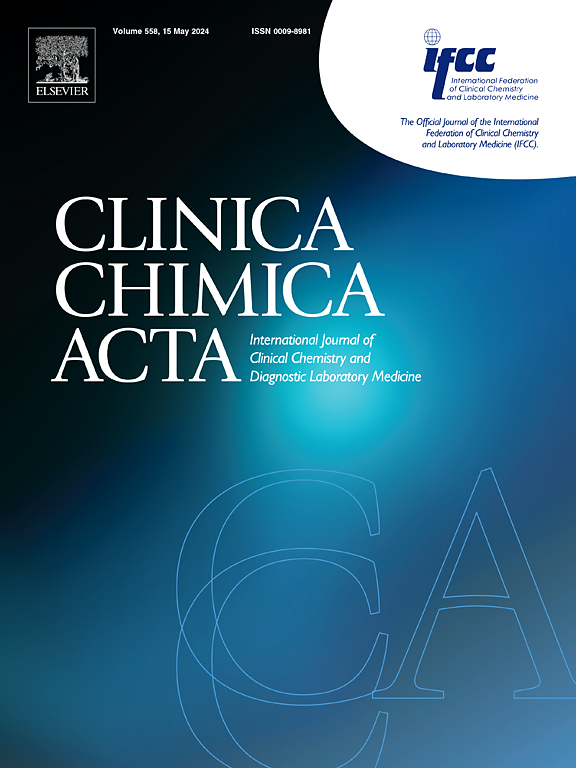脑脊液代谢途径改变作为原发性中枢神经系统淋巴瘤的诊断生物标志物
IF 2.9
3区 医学
Q2 MEDICAL LABORATORY TECHNOLOGY
引用次数: 0
摘要
原发性中枢神经系统淋巴瘤(PCNSL)是一种罕见的、侵袭性的血液系统恶性肿瘤,可以提出诊断挑战。早期发现对于有效治疗和改善患者预后至关重要。本研究的目的是评估代谢途径改变作为诊断和鉴别生物标志物的潜力。我们对脑/淋巴结的GEO转录组数据集进行了代谢组学分析。通过质谱分析,从PCNSL、转移性癌症和非恶性对照患者的脑脊液样本中验证了富集和重要的通路。接下来,我们利用机器学习模型来评估pcnsl与其他患者的分离性能,并开发诊断和鉴别诊断面板。从GEO数据集分析中发现了关键的代谢途径,并在PCNSL的脑脊液中显著富集。诊断面板上卟啉代谢和脂肪酸相关通路显著富集,AUC为0.88。此外,差异面板显著富集了氨基酰基trna生物合成、谷胱甘肽代谢和数条氨基酸途径,AUC为0.95。我们的研究强调了脑脊液代谢途径改变诊断PCNSL的生物标志物潜力,这可能导致PCNSL无创和可靠的诊断工具的开发。本文章由计算机程序翻译,如有差异,请以英文原文为准。
Metabolic pathway alterations in cerebrospinal fluid as diagnostic biomarkers for primary central nervous system lymphoma
Primary Central Nervous System Lymphoma (PCNSL) is a rare and aggressive type of hematological malignancy that can pose diagnostic challenges. Early detection is critical for effective treatment and better patient outcomes. The goal of this study was to assess the potential of metabolic pathway alterations as diagnostic and differential biomarker. We conducted a metabolomics analysis from GEO transcriptomic datasets on brain/lymph nodes. Enriched and significant pathways were validated from patient’s CSF samples from PCNSL, metastatic cancers and non-malignant controls, with mass spectrometry. Next, we utilized machine learning models to assess the separation performance of PCNSLs from other patients and develop diagnostic and differential diagnosis panels. Key metabolic pathways were discovered from GEO datasets analysis and significantly enriched in the CSF of PCNSL. Porphyrin metabolism and fatty acid-related pathways were significantly enriched from diagnostic panel and AUC was 0.88. Additionally, aminoacyl-tRNA biosynthesis, glutathione metabolism, and several amino acid pathways were significantly enriched from differential panel and the AUC was 0.95. Our study highlights the diagnostic biomarker potential of metabolic pathway alterations in CSF for PCNSL, which could lead to the development of non-invasive and reliable diagnostic tool for PCNSL.
求助全文
通过发布文献求助,成功后即可免费获取论文全文。
去求助
来源期刊

Clinica Chimica Acta
医学-医学实验技术
CiteScore
10.10
自引率
2.00%
发文量
1268
审稿时长
23 days
期刊介绍:
The Official Journal of the International Federation of Clinical Chemistry and Laboratory Medicine (IFCC)
Clinica Chimica Acta is a high-quality journal which publishes original Research Communications in the field of clinical chemistry and laboratory medicine, defined as the diagnostic application of chemistry, biochemistry, immunochemistry, biochemical aspects of hematology, toxicology, and molecular biology to the study of human disease in body fluids and cells.
The objective of the journal is to publish novel information leading to a better understanding of biological mechanisms of human diseases, their prevention, diagnosis, and patient management. Reports of an applied clinical character are also welcome. Papers concerned with normal metabolic processes or with constituents of normal cells or body fluids, such as reports of experimental or clinical studies in animals, are only considered when they are clearly and directly relevant to human disease. Evaluation of commercial products have a low priority for publication, unless they are novel or represent a technological breakthrough. Studies dealing with effects of drugs and natural products and studies dealing with the redox status in various diseases are not within the journal''s scope. Development and evaluation of novel analytical methodologies where applicable to diagnostic clinical chemistry and laboratory medicine, including point-of-care testing, and topics on laboratory management and informatics will also be considered. Studies focused on emerging diagnostic technologies and (big) data analysis procedures including digitalization, mobile Health, and artificial Intelligence applied to Laboratory Medicine are also of interest.
 求助内容:
求助内容: 应助结果提醒方式:
应助结果提醒方式:


